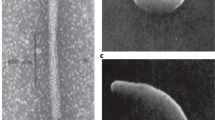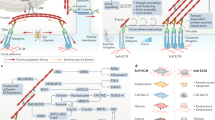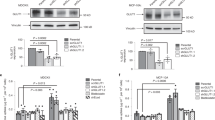Abstract
The response of cells to mechanical force1,2,3 is a major determinant of cell behaviour and is an energetically costly event4,5. How cells derive energy to resist mechanical force is unknown. Here, we show that application of force to E-cadherin stimulates liver kinase B1 (LKB1) to activate AMP-activated protein kinase (AMPK), a master regulator of energy homeostasis. LKB1 recruits AMPK to the E-cadherin mechanotransduction complex, thereby stimulating actomyosin contractility, glucose uptake and ATP production. The increase in ATP provides energy to reinforce the adhesion complex and actin cytoskeleton so that the cell can resist physiological forces. Together, these findings reveal a paradigm for how mechanotransduction and metabolism are linked and provide a framework for understanding how diseases involving contractile and metabolic disturbances arise.
This is a preview of subscription content, access via your institution
Access options
Access Nature and 54 other Nature Portfolio journals
Get Nature+, our best-value online-access subscription
$29.99 / 30 days
cancel any time
Subscribe to this journal
Receive 12 print issues and online access
$209.00 per year
only $17.42 per issue
Buy this article
- Purchase on Springer Link
- Instant access to full article PDF
Prices may be subject to local taxes which are calculated during checkout





Similar content being viewed by others
References
Borghi, N. et al. E-cadherin is under constitutive actomyosin-generated tension that is increased at cell–cell contacts upon externally applied stretch. Proc. Natl Acad. Sci. USA 109, 12568–12573 (2012).
Liu, Z. et al. Mechanical tugging force regulates the size of cell–cell junctions. Proc. Natl Acad. Sci. USA 107, 9944–9949 (2010).
Chen, C. S., Tan, J. & Tien, J. Mechanotransduction at cell–matrix and cell–cell contacts. Annu. Rev. Biomed. Eng. 6, 275–302 (2004).
Bernstein, B. W. & Bamburg, J. R. Actin-ATP hydrolysis is a major energy drain for neurons. J. Neurosci. 23, 1–6 (2003).
Daniel, J. L., Molish, I. R., Robkin, L. & Holmsen, H. Nucleotide exchange between cytosolic ATP and F-actin-bound ADP may be a major energy-utilizing process in unstimulated platelets. Eur. J. Biochem. 156, 677–684 (1986).
Guilluy, C. et al. The Rho GEFs LARG and GEF-H1 regulate the mechanical response to force on integrins. Nat. Cell Biol. 13, 722–727 (2011).
Marjoram, R. J., Guilluy, C. & Burridge, K. Using magnets and magnetic beads to dissect signaling pathways activated by mechanical tension applied to cells. Methods 94, 19–26 (2016).
Barry, A. K. et al. α-catenin cytomechanics—role in cadherin-dependent adhesion and mechanotransduction. J. Cell Sci. 127, 1779–1791 (2014).
Collins, C. et al. Localized tensional forces on PECAM-1 elicit a global mechanotransduction response via the integrin-RhoA pathway. Curr. Biol. 22, 2087–2094 (2012).
Kim, T. J. et al. Dynamic visualization of α-catenin reveals rapid, reversible conformation switching between tension states. Curr. Biol. 25, 218–224 (2015).
Bays, J. L. et al. Vinculin phosphorylation differentially regulates mechanotransduction at cell–cell and cell–matrix adhesions. J. Cell Biol. 205, 251–263 (2014).
Tzima, E. et al. A mechanosensory complex that mediates the endothelial cell response to fluid shear stress. Nature 437, 426–431 (2005).
Kishimoto, A., Ogura, T. & Esumi, H. A pull-down assay for 5′ AMP-activated protein kinase activity using the GST-fused protein. Mol. Biotechnol. 32, 17–21 (2006).
Zhou, G. et al. Role of AMP-activated protein kinase in mechanism of metformin action. J. Clin. Invest. 108, 1167–1174 (2001).
Walsh, S. V. et al. Rho kinase regulates tight junction function and is necessary for tight junction assembly in polarized intestinal epithelia. Gastroenterology 121, 566–579 (2001).
Ivanov, A. I., Hunt, D., Utech, M., Nusrat, A. & Parkos, C. A. Differential roles for actin polymerization and a myosin II motor in assembly of the epithelial apical junctional complex. Mol. Biol. Cell 16, 2636–2650 (2005).
Sebbagh, M., Santoni, M. J., Hall, B., Borg, J. P. & Schwartz, M. A. Regulation of LKB1/STRAD localization and function by E-cadherin. Curr. Biol. 19, 37–42 (2009).
Yoshida, C. & Takeichi, M. Teratocarcinoma cell adhesion: identification of a cell-surface protein involved in calcium-dependent cell aggregation. Cell 28, 217–224 (1982).
Nagafuchi, A., Shirayoshi, Y., Okazaki, K., Yasuda, K. & Takeichi, M. Transformation of cell adhesion properties by exogenously introduced E-cadherin cDNA. Nature 329, 341–343 (1987).
Zheng, B. & Cantley, L. C. Regulation of epithelial tight junction assembly and disassembly by AMP-activated protein kinase. Proc. Natl Acad. Sci. USA 104, 819–822 (2007).
Zipfel, P. A., Zhang, W., Quiroz, M. & Pendergast, A. M. Requirement for Abl kinases in T cell receptor signaling. Curr. Biol. 14, 1222–1231 (2004).
le Duc, Q. et al. Vinculin potentiates E-cadherin mechanosensing and is recruited to actin-anchored sites within adherens junctions in a myosin II-dependent manner. J. Cell Biol. 189, 1107–1115 (2010).
Chrzanowska-Wodnicka, M. & Burridge, K. Rho-stimulated contractility drives the formation of stress fibers and focal adhesions. J. Cell Biol. 133, 1403–1415 (1996).
Amano, M. et al. Phosphorylation and activation of myosin by Rho-associated kinase (Rho-kinase). J. Biol. Chem. 271, 20246–20249 (1996).
Puszkin, S. & Rubin, E. Adenosine diphosphate effect on contractility of human muscle actomyosin: inhibition by ethanol and acetaldehyde. Science 188, 1319–1320 (1975).
Shewan, A. M. et al. Myosin 2 is a key Rho kinase target necessary for the local concentration of E-cadherin at cell–cell contacts. Mol. Biol. Cell 16, 4531–4542 (2005).
Mehta, D. & Gunst, S. J. Actin polymerization stimulated by contractile activation regulates force development in canine tracheal smooth muscle. J. Physiol. 519, 829–840 (1999).
Cipolla, M. J., Gokina, N. I. & Osol, G. Pressure-induced actin polymerization in vascular smooth muscle as a mechanism underlying myogenic behavior. FASEB J. 16, 72–76 (2002).
Nash, R. W., McKay, B. S. & Burke, J. M. The response of cultured human retinal pigment epithelium to hypoxia: a comparison to other cell types. Invest. Ophthalmol. Vis. Sci. 35, 2850–2856 (1994).
Kahn, B. B., Alquier, T., Carling, D. & Hardie, D. G. AMP-activated protein kinase: ancient energy gauge provides clues to modern understanding of metabolism. Cell Metab. 1, 15–25 (2005).
Balaban, R. S., Kantor, H. L., Katz, L. A. & Briggs, R. W. Relation between work and phosphate metabolite in the in vivo paced mammalian heart. Science 232, 1121–1123 (1986).
Grashoff, C. et al. Measuring mechanical tension across vinculin reveals regulation of focal adhesion dynamics. Nature 466, 263–266 (2010).
Kannan, N. & Tang, V. W. Synaptopodin couples epithelial contractility to α-actinin-4-dependent junction maturation. J. Cell Biol. 211, 407–434 (2015).
Zhang, L., Li, J., Young, L. H. & Caplan, M. J. AMP-activated protein kinase regulates the assembly of epithelial tight junctions. Proc. Natl Acad. Sci. USA 103, 17272–17277 (2006).
Mammoto, T., Mammoto, A. & Ingber, D. E. Mechanobiology and developmental control. Annu. Rev. Cell Dev. Biol. 29, 27–61 (2013).
Janmey, P. A., Wells, R. G., Assoian, R. K. & McCulloch, C. A. From tissue mechanics to transcription factors. Differentiation 86, 112–120 (2013).
Klein, E. A. et al. Cell-cycle control by physiological matrix elasticity and in vivo tissue stiffening. Curr. Biol. 19, 1511–1518 (2009).
Levental, K. R. et al. Matrix crosslinking forces tumor progression by enhancing integrin signaling. Cell 139, 891–906 (2009).
Gemayel, C. & Waters, D. Mechanical or metabolic treatment for coronary disease: synergistic, not antagonistic, approaches. Cardiol. Rev. 10, 182–187 (2002).
Rice, K. M. et al. Diabetes alters vascular mechanotransduction: pressure-induced regulation of mitogen activated protein kinases in the rat inferior vena cava. Cardiovasc. Diabetol. 5, 18 (2006).
Maiers, J. L., Peng, X., Fanning, A. S. & DeMali, K. A. ZO-1 recruitment to α-catenin—a novel mechanism for coupling the assembly of tight junctions to adherens junctions. J. Cell Sci. 126, 3904–3915 (2013).
Peng, X., Cuff, L. E., Lawton, C. D. & DeMali, K. A. Vinculin regulates cell-surface E-cadherin expression by binding to β-catenin. J. Cell Sci. 123, 567–577 (2010).
Rodgers, L. S., Beam, M. T., Anderson, J. M. & Fanning, A. S. Epithelial barrier assembly requires coordinated activity of multiple domains of the tight junction protein ZO-1. J. Cell Sci. 126, 1565–1575 (2013).
Chappuis-Flament, S., Wong, E., Hicks, L. D., Kay, C. M. & Gumbiner, B. M. Multiple cadherin extracellular repeats mediate homophilic binding and adhesion. J. Cell Biol. 154, 231–243 (2001).
Bacabac, R. G. et al. Dynamic shear stress in parallel-plate flow chambers. J. Biomechan. 38, 159–167 (2005).
Arthur, W. T. & Burridge, K. RhoA inactivation by p190RhoGAP regulates cell spreading and migration by promoting membrane protrusion and polarity. Mol. Biol. Cell 12, 2711–2720 (2001).
Ren, X. D., Kiosses, W. B. & Schwartz, M. A. Regulation of the small GTP-binding protein Rho by cell adhesion and the cytoskeleton. EMBO J. 18, 578–585 (1999).
Acknowledgements
We thank T. Moninger and T. Washington at the University of Iowa for their assistance in performing experiments. Research reported in this publication was supported by The National Institutes of General Medicine (Award Number R01GM112805 to K.A.D.) and the National Cancer Institute of the National Institutes of Health (Award Number P30CA086862). Predoctoral fellowships from the American Heart Association (Award Number AHA 16PRE26701111) and National Institutes of Health (Award T32 GM067795) support J.L.B. and C.H., respectively. M.S. was supported by ‘Fondation ARC pour la Recherche sur le Cancer’ (ARC SFI20111203781) and CNRS-AMI Mecanobio (Mecapol_2016-2017).
Author information
Authors and Affiliations
Contributions
J.L.B. designed and performed experiments, analysed all the data, and helped write the manuscript. C.H. and H.K.C. helped with experimental design and procedures. M.S. provided cell lines and advised on their usage. K.A.D. helped with the experimental design, wrote the manuscript, and directed the project. All authors provided detailed comments.
Corresponding author
Ethics declarations
Competing interests
The authors declare no competing financial interests.
Integrated supplementary information
Supplementary Figure 1 The force-induced activation of AMPK occurs in multiple epithelial cell lines and requires E-cadherin and force transmission.
MDCK II (a,e) or MCF10A (b,c,f,g) cells were incubated with magnetic beads coated with IgG (as a control), a syndecan-1 antibody, or E-cadherin extracellular domains (E-Cad). The cells were then left resting (−) or tensile forces were applied to the beads (+), the cells were lysed, and total cell lysates were immunoblotted with antibodies that recognize AMPK (a,b,d,e,f), pAMPK (a,b,d,e,f), acetyl CoA carboxylase (c, ACC), acetyl CoA carboxylase phosphorylated at its AMPK specific site (c, pACC), or E-cadherin (e, E-cad). shE-cad indicates cells with E-cadherin silenced. shAMPK indicates cells with E-cadherin silenced. Compound C (Cmpd. C), Blebbistatin (Blebbi) and HECD-1 indicate cells pretreated with these reagents. (d,h) the assembly of cell–cell junctions was stimulated using a calcium switch assay, and the cells were lysed. The levels of pAMPK and AMPK were examined by immunoblotting (d) or E-cadherin was immunoprecipitated and AMPK association was monitored by immunoblotting (h). ′indicates minutes after Ca2+ re-addition. Steady indicates cells maintained in growth media. The graphs beneath the image show the average ± s.e.m. for 3 independent experiments. ∗∗, ∗, and #indicate P values of <0.001, <0.01, and < 0.05, respectively. NS indicates not significant. Unprocessed scans of blots are shown in Supplementary Figure 5.
Supplementary Figure 2 LKB1 and AMPK are upstream of Abl-mediated phosphorylation of Y822 vinculin and RhoA contractility.
MDCK II (a) or MCF10A (b–e) cells were incubated with magnetic beads coated with IgG (as a control) or E-cadherin extracellular domains (E-Cad). The cells were left resting (−) or tensile forces were applied to the beads (+), and the cells were lysed. (a,b) immunoblots of whole cell lysates showing phosphorylation of CrkL at the Abl-specific site (pCrkL). shLKB1 denotes cells with LKB1 silenced. shLuc indicates cells expressing a control vector cDNA, and cl.11 and cl.14 indicate two different clonal cell lines lacking LKB1. (c) immunoblots of whole cell lysates showing phosphorylation of vinculin Y822 (pY822). d, Active Rho (Rho–GTP) was isolated from whole cell lysates with GST–RBD and analyzed by western blotting. Compound C (Cmpd. C) indicates cells pretreated with this AMPK inhibitor. Y822F indicates MCF10A cells expressing a mutant vinculin containing a Y822F vinculin in place of the endogenous protein. (e) immunoblots of whole cell lysates showing myosin light chain (MLC), or MLC phosphorylated in its regulatory chain (pMLC). The graphs beneath each image represent an average of three experiments ± s.e.m.∗∗, ∗, # and ##indicate P values of <0.001, <0.01, <0.05 and <0.005, respectively. NS indicates not significant. Unprocessed scans of blots are shown in Supplementary Figure 5.
Supplementary Figure 3 Average fold activation of the glucose uptake and ATP values.
Bar graphs displaying the average fold activation of force-induced glucose uptake assays (a–d) or of the intracellular ATP levels (e,f) are shown. (a–c) The fold activations for the data presented in Fig. 4a–c are shown in panels S3a, S3b, and S3c, respectively. (d) The amount of glucose taken up into MCF10A cells after a calcium switch assay performed as described in supplemental Fig. 1f. (e,f) The fold activation for ATP levels presented in Fig. 4d, e are shown in panels S3e and S3f, respectively. The values represent the average fold activation from three independent experiments ± the standard error of the mean.
Supplementary Figure 4 Controls for shear stress studies in Fig. 5.
(a–h) MDCK II cells (n = 79) or two clonal MDCK II cells lines (cl.11 and cl.14, n = 51 and 76 respectively) lacking LKB1 were left untreated, treated with inhibitors of AMPK (Compound C = Cmpd. C, n = 55), treated with inhibitors of ATP synthesis (Oligo A, n = 53 or Carbonyl cyanide-4-(trifluoromethoxy)phenylhydrazone = FCCP, n = 29), treated with inhibitors of myosin II (blebbistatin = Blebbi, n = 30), treated with the AMPK activator (A-769662), or incubated in low glucose containing media (Low Gluc, n = 25). The cells were left resting (no shear) or exposed to shear stress (shear). (a–d) The cells were fixed, stained with antibodies against E-cadherin or with Texas-Red-labelled phalloidin, and visualized using confocal microscopy. Representative images are shown in a and d. Scale bars, 20 μm. The graph in b and c represent the average corrected fluorescence intensity of E-cadherin (b, E-cad) or F-actin (c) in junctions. The data are represented as a box and whisker plot with median, 10th, 25th, 75th, and 90th percentiles shown. (e) the cells were fixed, stained with antibodies against vinculin or β-catenin, and examined by confocal microscopy. The graphs represent the average corrected fluorescence intensity of vinculin (f) or β-catenin (g) in junctions. (h) the cells were lysed and total cell lysates were immunoblotted with antibodies against myosin light chain (MLC) or MLC phosphorylated at Serine 19 (pMLC). The graphs beneath each image represent an average of three experiments ± s.e.m. ∗∗, ∗ and # indicate P values of <0.001, <0.01 and <0.05, respectively. NS indicates not significant. Unprocessed scans of blots are shown in Supplementary Figure 5.
Supplementary information
Supplementary Information
Supplementary Information (PDF 1090 kb)
Rights and permissions
About this article
Cite this article
Bays, J., Campbell, H., Heidema, C. et al. Linking E-cadherin mechanotransduction to cell metabolism through force-mediated activation of AMPK. Nat Cell Biol 19, 724–731 (2017). https://doi.org/10.1038/ncb3537
Received:
Accepted:
Published:
Issue Date:
DOI: https://doi.org/10.1038/ncb3537
This article is cited by
-
LIS1 RNA-binding orchestrates the mechanosensitive properties of embryonic stem cells in AGO2-dependent and independent ways
Nature Communications (2023)
-
Engineering biomaterials to tailor the microenvironment for macrophage–endothelium interactions
Nature Reviews Materials (2023)
-
Hydrogel dressing integrating FAK inhibition and ROS scavenging for mechano-chemical treatment of atopic dermatitis
Nature Communications (2023)
-
The AMPK-Sirtuin 1-YAP axis is regulated by fluid flow intensity and controls autophagy flux in kidney epithelial cells
Nature Communications (2023)
-
Lima1 mediates the pluripotency control of membrane dynamics and cellular metabolism
Nature Communications (2022)



